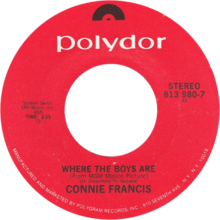
Concetta Rosa Maria Franconero , known professionally as Connie Francis, is an American pop singer, actress, and top-charting female vocalist of the late 1950s and early 1960s. Called the "First Lady of Rock & Roll" in one headline of a marginal publication, she is estimated to have sold more than 100 million records worldwide.
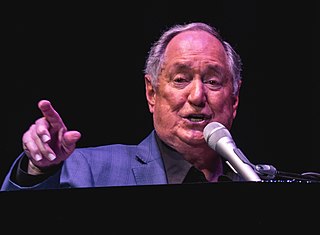
Neil Sedaka is an American singer-songwriter and pianist. Since his music career began in 1957, he has sold millions of records worldwide and has written or co-written over 500 songs for himself and other artists, collaborating mostly with lyricists Howard "Howie" Greenfield and Phil Cody.

Howard Greenfield was an American lyricist and songwriter, who for several years in the 1960s worked out of the famous Brill Building. He is best known for his successful songwriting collaborations, including one with Neil Sedaka from the late 1950s to the mid-1970s, and near-simultaneous songwriting partnerships with Jack Keller and Helen Miller throughout most of the 1960s.

Where the Boys Are is a 1960 American CinemaScope comedy film directed by Henry Levin and starring Connie Francis, Dolores Hart, Paula Prentiss, George Hamilton, Yvette Mimieux, Jim Hutton, and Frank Gorshin. It was written by George Wells based on the 1960 novel of the same name by Glendon Swarthout. The screenplay concerns four college co-eds who spend spring break in Fort Lauderdale. The title song "Where the Boys Are" was sung by Connie Francis, who also co-starred in a supporting role.

"Everybody's Somebody's Fool" is a song written by Jack Keller and Howard Greenfield that was a No. 1 hit for Connie Francis in 1960. A polka-style version in German, "Die Liebe ist ein seltsames Spiel", was the first German single recorded and released by Connie Francis, and it reached No. 1 on the single chart in 1960 in West Germany.
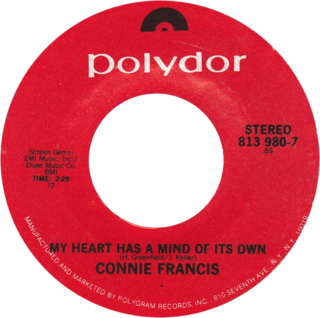
"My Heart Has a Mind of Its Own" is a song written by Howard Greenfield and Jack Keller which was a No. 1 hit for Connie Francis in 1960.

"Love Will Keep Us Together" is a song written by Neil Sedaka and Howard Greenfield. It was first recorded by Sedaka in 1973. The brother-sister duo Mac and Katie Kissoon recorded their version of the song in 1973. American pop duo Captain & Tennille covered the song in 1975, with instrumental backing almost entirely by “Captain” Daryl Dragon, with the exception of drums played by Hal Blaine; their version became a worldwide hit.
"Follow the Boys" is a 1963 romantic ballad written to serve as the theme song for the 1963 comedy film of the same name: the song was introduced in the film by its top billed star: Connie Francis, for whom "Follow the Boys" was a Top 20 hit single.
"Breakin' in a Brand New Broken Heart" is a popular song written by Howard Greenfield and Jack Keller.
Fallin' is a song written by Neil Sedaka and Howard Greenfield, that was recorded by Connie Francis on 2 September 1958 at Metropolitan Studio (NYC) in a session produced by Morton "Morty" Kraft who also conducted.

"Stupid Cupid" is a song written by Howard Greenfield and Neil Sedaka which became a hit for Connie Francis in 1958.

"Lipstick on Your Collar" is a song written by Brill Building staff writers Edna Lewis (lyrics) and George Goehring (music) which was a 1959 hit single for Connie Francis.
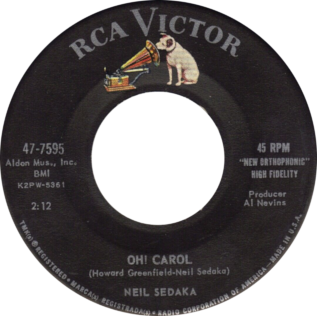
"Oh! Carol" is an international hit written by Neil Sedaka in 1958. Co-written with Howard Greenfield, the song is noted for Sedaka's spoken recitation of the verse, the second time around.
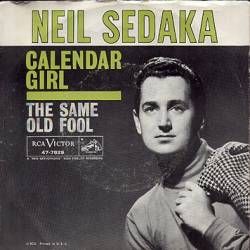
"Calendar Girl" is a song by Neil Sedaka. The music was composed by Sedaka and the lyrics by Howard Greenfield. Recorded in 1959 and released in December 1960 as a single, it was a Top-5 hit single for Sedaka, peaking at No. 4 on the US charts, No. 3 in Australia, and No. 1 on the Canadian and Japanese charts.
"The Diary" is a song by Neil Sedaka and Howard Greenfield. It was released in 1958 as Sedaka's debut single.
Rock with Neil Sedaka or just Neil Sedaka is the first major solo album of Neil Sedaka released in 1959 after two 1958 albums under the titles Neil Sedaka and The Tokens and Neil Sedaka and The Tokens and Coins. The album was released by RCA Victor and was produced by Al Nevins. The album contains 12 songs, all of them co-written by Sedaka and his friend Howard Greenfield. Two of the songs became successful singles for Sedaka from the album, namely "The Diary", his debut single that was a hit, reaching No. 14 on the US Billboard charts, and "I Go Ape", a single that was relatively successful in the United States reaching No. 42, but did far better in the UK Singles Chart, making it up to No. 9 and his debut single in the United Kingdom.

Neil Sedaka Sings Little Devil and His Other Hits is a solo album by Neil Sedaka released in 1961 immediately after the cover versions of earlier hits in Circulate.
"Run Samson Run" is a song written by Neil Sedaka and Howard Greenfield and sung by Neil Sedaka. It appears on his album Neil Sedaka Sings Little Devil and His Other Hits. The song was included in Neil Sedaka Sings His Greatest Hits (1959–1963).

Neil Sedaka: Now is a studio album by American songwriter and pop star Neil Sedaka. It was released in 1981 by Elektra Records, and was the last Sedaka album to be released on that label. As with other Neil Sedaka albums of that period, it was released in Europe on the Polydor label.

"Our Last Song Together" is a 1973 song recorded by Neil Sedaka. It is a track from his LP The Tra-La Days Are Over, and was the third of four single releases from the album.
